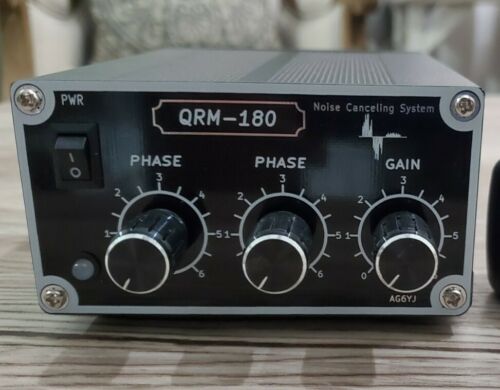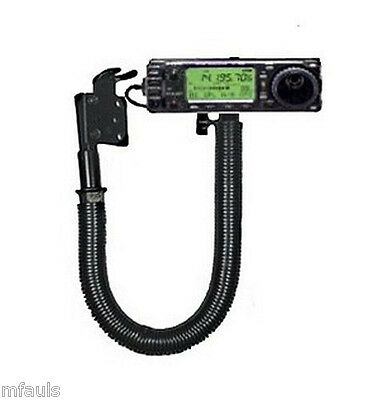-40%
QRM-180 Noise Canceling System kit by AG6YJ HF amplifier RF linear QRN x-phase
$ 58.07
- Description
- Size Guide
Description
This is a kit, doesn’t comes assembled, please make sure you know what are you buying. Includes assembly and operating instructions.I have a service to assemble it, please send a message for details.
This is a kit. It is not a very difficult kit but it will take you some time to assemble. There are no small surface mount parts, they are all large through-hole parts and fairly easy to solder. All the needed parts, connectors, case, and power supply are included but you will need a small soldering iron and some basic hand tools. The instruction manual is pretty good, and is included with each kit.
First, these devices rely upon getting a good sample of the noise signal
separate
from the primary signal. That means that you must do some work to devise a suitable noise antenna. A length of wire tossed on the shack floor is seldom satisfactory, unless your computer is the offender and the wire accidentally lands on it. If you can manage a crude 6M dipole, that seems to work well for about 90% of users in the 80-10M bands. If your noise is being generated by nearby power lines, solar panels, motors, or computers, one of these devices can make a dramatic difference.
This is not the same device as the x-phase
which is seemingly everywhere on ebay. That device had the right idea but was missing some important features. If you bought one of those, don’t be too critical of other noise canceling devices. The ANC-4, our QRM-180, and even the MFJ-1026 are significantly better units.
The big failing of the X-phase is that it is nearly impossible to get a large enough noise signal without having an antenna so large that is also picking up the desired signal. So the good signal gets canceled along with the noise. If you already bought an X-phase the easy remedy is to add an amplifier on the noise input. Ebay sells LNAs for that frequency range for under that solves that problem. You could also use an active antenna which would then provide a decent sample of the noise. Like the commercial units, the QRM-180 has a built-in amplifier to boost the noise input to the needed level.
The QRM-180 also has the following additional features:
Larger antenna switching relay which can handle 250W pep.
Fuses on all of the antenna inputs to protect the circuitry.
Level adjust on the preamp to match the noise antenna size.
Buffer amplification on the output so that the volume doesn't need to be adjusted when the device is used.
RF detection circuitry to automatically switch out the device during transmit. Used as a backup safety feature.
Bypass capacitors throughout the circuitry to reduce power supply noise and to protect against RF.
Quality two sided PCB with ground planes on both sides.
Adjustable time delay after transmit.
These devices are generally targeted for amateur radio, but they will work equally well on receiver only and SDR applications. Again, they can do a good job canceling a local noise source, but not atmospheric noise. There are a lot of reviews on line as well as a bunch of YouTube videos that give some useful information on tuning them and noise antenna design.
The case is a compromise between being roomy enough for fumble-fingered assembly and not so big as to take up valuable space next to the transceiver. It sits comfortably on top of most external speakers, or on top of the transceiver itself. It is thick aluminum so it is well shielded and heavy enough not to slide about during use. The electronics is easily removable from the enclosure for assembly and service. The front and rear panels are made from PCB material with copper ground planes on both sides to complete the shielding of the enclosure.
From the manual:
Unless you live far out in the countryside you likely have your share of RF interference from TVs, LED lamps, power lines, computers, solar panels, etc. A common method to reduce QRM (popular since the days of vacuum tube TVs) is to use a second antenna to collect a suitable sample of the noise, invert that signal and add it back to the main signal. It it is a fairly straightforward design that doesn’t rely upon clever filters and traps specific to the type of noise.
And the good news is that they can be reasonably effective. Don’t expect miracles but one of these can get rid of enough noise to make them well worth having. A number of commercial versions available today are targeted especially for amateur radio, and while they are designed with amateur radio transceivers in mind, they will work equally well on receiver only and SDR applications. Again, they can do a good job canceling a local noise source, but not atmospheric noise. There are a lot of reviews on line as well as a bunch of YouTube videos that give some useful information on tuning them and noise antenna design.
The QRM-180 came about because the commercial units actually worked but seemed to be missing some needed features. Unfortunately they are largely built with surface mount components and were difficult to modify. The QRM-180 board (with ground-plane top and bottom) managed to fix many of the shortcomings (my subjective opinion) of the commercial units. The circuitry is not all that original, it is a combination of what was deemed to be the best of the existing designs. The board is all through-hole components which makes it much, much easier than surface mount to build by hand and also makes it serviceable in the future. The circuit could have been laid out with surface mount and machine assembled (much cheaper) but selling the kits is a way to encourage more hands-on involvement in ham radio. Early hams had Heathkits, Allied Radio, Eico kits, EMC, and others, but now there are just too few useful kits on the market.
The case is a compromise between being roomy enough for fumble-fingered assembly and not so big as to take up valuable space next to the transceiver. It sits comfortably on top of most external speakers, or on top of the transceiver itself. It is thick aluminum so it is well shielded and heavy enough not to slide about during use. The electronics is easily removable from the enclosure for assembly and service. The front and rear panels are made from PCB material with copper ground planes on both sides to complete the shielding of the enclosure.
















